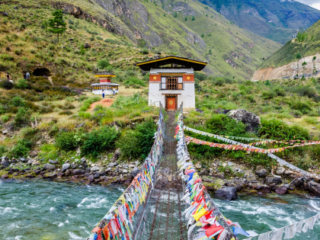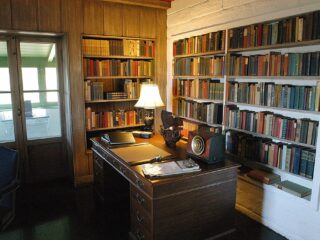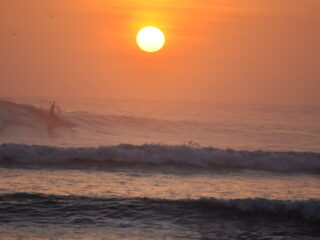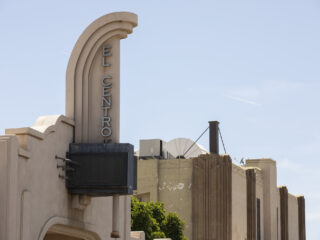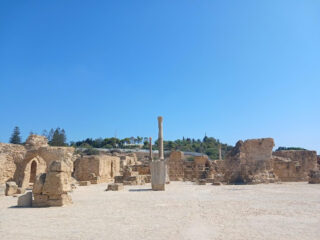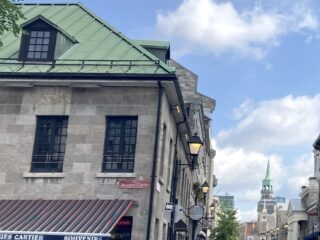by Ken Haigh
When the steamer, “Portland”, docked in Seattle on July 17, 1897, people were just sitting down to their breakfasts, unaware that this day would be any different from the one before. An enterprising reporter for the Post-Intelligencer knew differently. He had already been on board the “Portland “and he knew that she carried two tons of gold from the Canadian northwest. GOLD! GOLD! GOLD! GOLD! screamed the headline that morning, in a cry that would soon be echoed around the world. It was welcome news to a nation grappling with a severe economic recession. “Prosperity is here”, the reporter wrote confidently, “the depression is at an end.”
Within weeks, tens of thousands were heading for the gold fields of the Klondike, convinced that the nuggets were lying so thick on the ground that you could literally pick them up and stuff your pockets full. One of those who heeded the siren’s call was a twenty-one year-old Oakland, California native named Jack London. Like millions of other Americans, London was desperate. He had been an oyster pirate, a sealer, and a hobo; had worked in a cannery, a jute mill and a laundry; and had dreamed of being a writer, but had met with little success. Borrowing money from his step-sister, he set sail for the Klondike, confident of making his fortune.
There were several routes to the goldfields. Some took the overland route through the Canadian West. Others took the steamer up the Yukon River from Alaska. But most, like London, booked a passage on one of many steamships leaving from ports like San Francisco, sailed up the Inside Passage to the Lynn Canal and then disembarked at Dyea or Skagway in the Dyea Inlet. In Dyea, London would have to hump his gear (quite literally a ton of supplies) over the Chilkoot Pass to Lindemann Lake, the head of navigation on the Yukon River. On the shores of Lindemann Lake, in a great tent city, London and his three companions built a pair of flat-bottomed boats he christened Yukon Belle and The Belle of the Yukon to carry them downstream to Dawson. All around them the spruce forest fell as eager prospectors constructed simple craft to navigate the river to the gold fields. It was a race and everyone knew that the first to arrive would stake the best claim.
Over one hundred years later, my friend, Rob, and I would also be traveling this route, following the trail of the Klondike Gold Rush. Our traveling companion was Daisy, an elderly Labrador Retriever. We would be traveling in a canoe, not a home-made boat, and would be starting at Whitehorse, not Lindemann Lake, but we would still be facing many of the same dangers as London did in 1897.
Our journey would cover over 400 miles and take us twelve days. London and his crew started well, handily navigating the chain of lakes that began their journey. We were less fortunate. It took us two days to paddle the length of Lake Laberge. Intermittent drizzle and stiff headwinds kept forcing us to the shore, where we huddled miserably, waiting for the weather to break. Finally we reached the outlet of the lake and the ghost town of Lower Laberge. Collapsing into the forest were the remains of a Northwest Mounted Police post, a telegraph station, a road house, a shipping office and an icehouse. The bush was carpeted with rusting cans and a sign warned us NOT to pick up the garbage. A 1936 Chevy pickup, riddled with bullet holes, and with the logo Stewart & Phillips etched on the door, subsided gently into a patch of purple fireweed. For the next ten days we would pass countless small towns like this. Many had been simple wood camps, built after the Gold Rush to supply the paddlewheelers, which had once plied the Yukon River, with fuel. The entire river was one big open air museum.
London’s first test was the pair of rapids at Miles Canyon and Whitehorse. He and his companions had a choice. They could play it safe and take two days to portage everything around the rapids, or they could risk everything and run the rapids in a matter of minutes. They took a vote and opted for the latter. Spectators cheered them on as they successfully ran the rapids and the next thing they knew they were being offered money to pilot other outfits through the dangerous waters. At a price of twenty-five dollars per journey, Jack and his crew steered 120 boats through the rapids over the next few days. They could have stayed all summer and earned themselves a fortune, but they were impatient to reach the gold fields.
Rob and I also had our own set of rapids to run called the “Five Fingers”. The rapids got their name because four tall basalt columns divided the river into five narrow channels. Legend has it that a net was stretched below these rapids during the gold rush to catch the bodies of drowned prospectors. So it was with great trepidation that we approached these giant columns. It didn’t help that the Klondike Highway ran parallel to the river here and that the Territorial Government had constructed a viewing platform above the rapids. I called to my friend and pointed upwards.
“Yah, I see them”, he muttered.
A busload of tourists craned their cameras over the railing, hoping to catch our deaths in glorious Technicolor.
“What’s that?” asked Rob.
I heard it too, a drone, like a hive of bees, above the roar of the water. Then right before my eyes, over the lip of the rapids, rose a baseball cap, then a stoic face with a pipe clamped between its teeth, then square shoulders clad in plaid flannel ,a strange apparition rising straight out of the foam. I realized that what I was seeing was a man standing at the tiller of his aluminum dory driving straight UP the deadly rapids. Needless to say, the reports of my death have been greatly exaggerated. The Five Finger Rapids turned out to be no more dangerous than a child’s playground slide.
The real dangers on the river turned out to be less dramatic. Because the current was so strong, the greatest danger was that you would capsize on a hidden gravel bank or be knocked overboard by a sweeper, an undercut tree leaning out over the river’s surface. The other danger on the river had teeth and an appetite for free food. Every traveler we encountered had met a Grizzly. We never did, but then we had a dog and kept a very clean camp.
Freeze-up caught London and his companions at the mouth of the Stewart River. They were only 75 miles from their goal, but they were stuck until spring. They moved into an abandoned cabin and began to lay in a stock of firewood for the long winter. Though he did a little prospecting, London and his friend Thompson once thought they had struck the motherlode, only to find they had been filling their pokes with fool’s gold. He spent most of the winter mixing with the other prospectors who were also trapped at Stewart River. London’s garrulous nature and his storytelling skills meant that his cabin became the focus of social life during the long winter months. With spring break-up, London was back on the river. He was closer to Dawson than he knew.
Gold was eventually discovered on the Stewart River and a small town formed near the place where London had overwintered. At the height of its prosperity, Stewart City had perhaps a thousand residents. Rob and I had hoped to see the remains of the small town, but the river has shifted its course and most of the town has vanished into the Yukon River. Today, the few remaining buildings, like the former Hudson’s Bay Company store, perch precariously above a steep cutbank, while the river gnaws at their foundations. We camped near the town site, but got little sleep. All night long, great sections of the bank collapsed into the river with a roar like cannon shot.
The next day we were out on the river early. We made incredible time. The river was barreling along like a freight train and we barely had to dip a paddle. The river was now the color of caf au lait and the noise of the silt washing the hull sounded like two sandpaper blocks rubbing together. We passed several homesteads, a few active placer mines and numerous Indian fishing camps, where rows of split red salmon hung smoking over fires like washing on a line. By dusk, the Midnight Dome heaved into sight, its famous scar glowing red. At the foot of the mountain, Dawson City sprawled in the low ground between the Yukon and Klondike rivers.
Dawson’s appeal is immediately apparent. Because it’s heyday was so short-lived, much of the town lies abandoned, still looking as it did when London first arrived. Some of the buildings, like the Palace Grand Theatre, have been restored, but most stand at crazy angles, slowly subsiding into the earth. When London reached Dawson in the spring of 1898, he was too late. The best claims had already been staked. He didn’t know it, but the money he’d made as a river guide was the only money he would earn in the Klondike. He stayed for the summer, and then, his health ruined by scurvy and starvation, and not wishing to spend another winter in the Klondike, he and two companions took a small boat down the river to the sea. He worked his passage to Vancouver as a stoker on a steamship and then rode the rails home to California.
In 1936, trappers discovered the ruins of London’s cabin identifiable by his signature scratched on the back wall. Volunteers dismantled the structure and moved it to Dawson. Half of the logs went to Jack London Square in Oakland and the other half was used to construct a replica of the cabin in Dawson City. Today the cabin is the focus of the Jack London Interpretive Centre, where visitors can learn about the author and his life in the Yukon. For London did discover gold in the Klondike. Later, he would write: “It was in the Klondike I found myself. There nobody talks. Everybody thinks. You get your true perspective. I got mine.” When he returned to California he began to turn out articles and short stories based on his northern experience, gaining recognition as a promising new voice in American letters. When he published The Call of the Wild in 1903 his fortune was secure.
Other Literary Stops in Dawson City:
Dawson City has other claims on the literary traveler. Just down the street from London’s cabin, is the log cabin where the poet Robert W. Service lived. Born in England, Service came to the Yukon in 1904, as a teller in the Canadian Bank of Commerce. Even though he missed the gold rush, Service drew inspiration from the tales of the veteran Klondikers (or sourdoughs) for his Kiplingesque verse. His first book of poems, Songs of a Sourdough (1907), made him famous. Even today, Canadian schoolchildren are familiar with poems like The Shooting of Dan McGrew. Rob and I killed time on Lake Laberge reciting The Cremation of Sam McGee in the rain, wondering what a marge is and how does one moil? Today, the cabin is a museum and, in the summer season, an actor entertains literary pilgrims with recitations of Service’s verse.
Across the street from Service’s cabin, is the birthplace of Canadian broadcaster and best-selling author, Pierre Berton, who died in 2004. Berton’s Klondike is still the best general history of the gold rush. Berton’s house has been restored, not as a museum, but as the home for a writer-in-residence program. Here, Canadian writers can live rent-free for up to six months while they polish their latest literary creations. It’s nice to know that, even today, the Klondike continues to inspire a new generation of literary talent.

